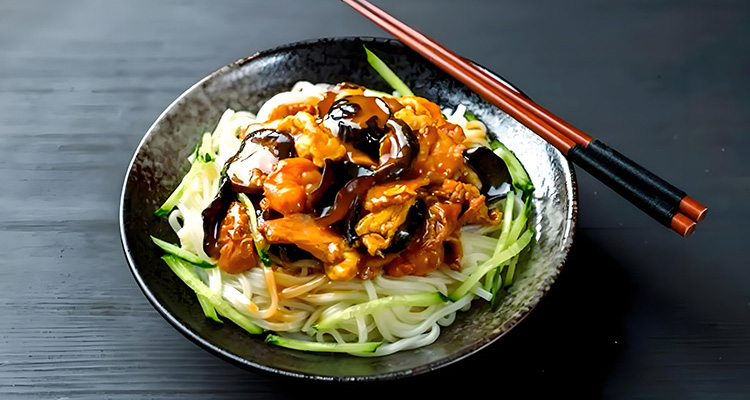Shanxi Da Lu Mian: Hearty Taiyuan Breakfast
When the first light falls on Taiyuan’s old streets, a warm, familiar aroma rises from small breakfast stalls: Shanxi Da Lu Mian. This savory noodle bowl—Taiyuan breakfast at its best—combines handmade, chewy noodles with a rich mushroom-and-pork gravy. Sit at a local shop, hear the regional dialect, lift a tangle of noodles and taste a bowl that wakes the senses and fuels a day of exploration.
1. Origin and History: A Bowl Packed with Shanxi Merchant Wisdom
Da Lu Mian is rooted in Shanxi’s long-standing wheat culture and the entrepreneurial history of the Shanxi merchants. On the dry Loess Plateau, wheat became the staple, and noodles proliferated. During the Ming and Qing eras, traveling merchants needed food that was nutritious, flavorful, and storable. Locals slow-simmered pork, dried mushrooms, wood ear, golden needle mushrooms, and other preserved ingredients into a concentrated gravy—an umami-rich “lu” that preserved well and boosted flavor. Over time this practical travel food became an everyday breakfast in Taiyuan and Jinzhong, a local breakfast classic.
2. Cultural Meaning: Morning Rituals at the Breakfast Table
For many Shanxi families, Da Lu Mian means more than food: it marks the start of the day. Traditionally served on important mornings or festivals, a hearty bowl implied prosperity and warmth. For those leaving for work or school, it served as a loving send-off. Even today, in Taiyuan’s bustling noodle shops you can watch neighbors slurp, sip the broth, and chat—this bowl connects past and present and offers an honest window into Shanxi’s down-to-earth life philosophy.

3. Ingredients and Flavor: A Harmony of Mountain Ingredients and Meaty Depth
The soul of Da Lu Mian is its lu gravy. Typical components turn a simple noodle into a layered taste experience:
- Ingredients: Slices of fatty and lean pork for aroma; rehydrated black wood ear for chewiness; shiitake mushrooms for wild, savory notes; enoki (golden needle) mushrooms for texture; sometimes daylily and fried tofu puffs for body. Beaten egg is added at the end to create silky ribbons.
- Flavor and Texture: The perfect lu is thick but not gluey, savory without overpowering saltiness. First come pork and shiitake richness, then mushroom umami, with a subtle soy and toasted aroma. Handmade noodles must be chewy and springy, giving contrast to the soft, velvety gravy.
4. Making It: Craftsmanship in Every Step
A genuine Da Lu Mian takes attention:
- Rehydrate dried ingredients for hours so they regain fullness and release flavor.
- Sauté pork to render fat, add aromatics like scallion, ginger, and star anise, then stir in rehydrated mushrooms and other dried goods.
- Add soy sauce, dark soy for color, rice wine, and the soaking liquid from the mushrooms (a key umami boost), then simmer on low for at least 30 minutes.
- Thicken with a cornstarch slurry until glossy, then slowly whisk in beaten egg to form delicate egg ribbons.
- Meanwhile boil handmade noodles until just cooked, rinse briefly if desired for texture, then place in a bowl and ladle piping-hot lu over them.

5. How to Eat: Slurp Like a Local
To enjoy Da Lu Mian as locals do:
- The finishing touch is Shanxi aged vinegar—pour a small amount around the bowl rim to brighten and cut richness.
- Mix gently from the bottom so noodles pick up the gravy, then dig in. Locals often pair the bowl with pickled vegetables or raw garlic for contrast.
- Breakfast is prime time; seek busy, slightly worn noodle shops in Taiyuan neighborhoods for the most authentic taste. Many places serve a free cup of the noodle broth after the bowl—drink it to complete the experience.
6. Traveler Tips
- Ordering: Say “One Da Lu Mian, please.” Tell the vendor any dietary restrictions—many recipes use pork.
- Pairings: Try a small cold cucumber salad or marinated tofu to balance the rich gravy.
- Cultural note: Don’t be shy about slurping—it’s a compliment to the cook.

7. Simple Home Version: Bring Shanxi Flavor Home
Easy Da Lu Mian at home:
- Soak dried shiitake, wood ear, and enoki (or use fresh mushrooms) and slice pork.
- Heat oil, sauté scallion and ginger, cook pork until browned, then add mushrooms and stir-fry.
- Add mushroom soaking liquid and water, season with light and dark soy, a pinch of sugar, salt, and white pepper; simmer 15 minutes.
- Thicken with cornstarch slurry.
- Slowly pour in beaten egg to create egg ribbons.
- Cook fresh or store-bought wheat noodles, drain, and pour the hot gravy over.
Finish with a splash of Chinese aged vinegar.

Conclusion and Call to Action
Shanxi Da Lu Mian—this bowl carries merchant history and home-cooking wisdom. Its straightforward presentation, robust ingredients, and comforting flavors perfectly reflect Shanxi’s honest character. When you plan a trip to Taiyuan, save a morning to sit in a local noodle shop and order this signature breakfast. Let its rich aroma and bold taste become one of your most vivid Shanxi memories—your chopsticks are ready to discover the story in every bite.


